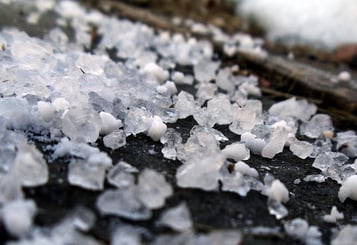The Most Common Questions About Salt and Deicer

Each year the Schill team goes through thousands of pounds of bulk salt and many gallons of liquid deicer in the battle against snow and ice. It’s a truly vital commodity that helps us keep streets and parking lots drivable and walkways traversable.
Nevertheless, every property is different and therefore requires different attention when it comes to applying deicing materials, and that can be confusing for property managers trying to predict and manage their seasonal expenses. We service some retail properties and hospitals literally 24 hours per day to make sure that they never have ice on the ground. This is important because they potentially have foot traffic around the clock. On the other hand, some other properties are only treated before, after, and/or during a snow event.
While our customers trust us to make sound judgements on when to apply deicers, we understand that that it’s important to be able to anticipate when you might be charged. So, because we at Schill Grounds Management value transparency in our pricing and procedures, we wrote this article answer the most common questions we receive in order to demystify this process.
"Why is salt so expensive?"

We allow our customers to pay by the ton/pound or per application, and each option has its benefits. Paying by the ton means that you only pay for the amount of salt that’s applied to your property. However, paying a flat fee per application can potentially allow our customers to save money if weather conditions are especially bad and a large amount of product needs to be used.
Whether we use bulk salt, bagged material, or a mix is determined by the property type, weather, and ambient tempertatures.
As with most services, deicing is a factor of material and labor costs. And as we mentioned before, salt is a commodity and its price is set based on the market constraints of supply and demand. When winter weather is at its worst, prices will rise due to the spike in demand, while milder weather will lead to lower costs.
Across our industry, labor has been increasingly difficult to come by. Currently, the unemployment rate is lower than it's been in several years, and that means that we need to be increasingly creative about how we provide service. To meet these challenges, we're at the forefront of using innovative technologies that allow us to do more work with fewer people. We use vehicles that plow snow and spray liquid deicers at the same time, essentially allowing one person to do the work of three.
It's All about safety and risk management
The amount and deicing method we use on your property depends on your level of risk, and every property will require a different solution. For example, hospitals and retail properties have higher levels of foot and automobile traffic and will therefore often require more material to keep their customers and visitors safe. Condo's and HOA's, on the other hand, don't need anywhere near as much. And a historical monument or site, for instance, requires a deicing solution that's minimally erosive and corrosive to preserve its structural integrity.
"How Do you prevent over-usage of materials?"
Here at Schill, all of our machines are callibrated, meaning that we can measure with great accuracy how much product we're using at all times. Efficiency is something that we're always monitoring to keep up with ISO best practices, so we not only record that data for billing purposes, but we also analyze it to refine how we operate.
As we mentioned before, salt and liquid deicer (which also typically contains salt in the form of chloride) can both cause damage to plants, buildings, and hardscapes. Because we consider ourselves to be stewards of the environment, we also constantly compare early estimates of what is needed with the actual use of materials to in order to make sure we're making the best use of our resources. This helps to insure that we have a minimal negtative impact on the earth.
"Who determines when salt or deicer is applied?"
As your snow and ice management contractor, we're the ones who decide when and how much deicing material your property needs. This can be a point of contention for our potential clients, so we want to be as upfront about our process as possible.
When there’s a dusting of snow that maybe hasn’t accumulated enough to plow, we apply deicing material instead to melt it and keep the snow from bonding with the pavement.
This helps to make sure that your customers or tenants always have a firm footing. However, when snowfall is heavier, our crews clear your property of snow before we apply deicers so that you have a wet parking lot when we’re done.
On demand
 We understand that you have a budget for your monthly winter expenses, and we try to work within that. Nevertheless, safety is our main priority and we try to choose snow customers who share the same primary concern.
We understand that you have a budget for your monthly winter expenses, and we try to work within that. Nevertheless, safety is our main priority and we try to choose snow customers who share the same primary concern.
Again, while we're the ones who make the decision about whether and when your property gets treated, our customers do have some say in the matter. For instance, many of the condominium and HOA properties we service prefer to let us know when they want salt applied.
This is often to keep winter maintenance costs, which are passed on to the HOA members themselves, as predictable as possible. While we’re always happy to oblige customers like these, their requests are only completed after our regularly scheduled customers get serviced.
If you don’t want to be placed at the back of the queue, it’s best to make a plan for ice melt products to be used throughout the season when your contract is being discussed.
"What are my other options?"
Liquid deicer is a great alternative to salt for many reasons: for one, it takes fewer crew members to apply it, which cuts down on labor costs. Furthermore, the actual price of liquid deicer also tends to be cheaper, though the amount of savings varies with the constantly changing price of salt.
It also causes less damage to your plants, as salt can cause them to dry out. Salt is also erosive, which means that it can also damage building exteriors and as well interiors when employees, tenants, or customers track it in with their shoes.
Because of these reasons, pretreatment with liquid deicer is a great alternative for property managers and owners who want their walkways to be free of ice and snow at all times, but are also hesitant to incur the price tag that salt may bring. Instead of waiting for snow to fall, we’re checking the radar for signs of snow as well as future road temperature predictions to foresee whether ice may form, and based on that information, we head out ahead of time to apply deicer. Using it this way (as a pretreatment) on the properties we serve allows for walkways to be clear of ice at all times at a fraction of the cost of salt.
Trust Schill to provide the right snow and ice solutions
Here at Schill, we know what we’re doing when it comes to protecting your property. If you’re located in the Northern Ohio area, feel free to get in touch with us. We’re happy to answer any questions you might have about keeping your property safe this winter.
Photo Credit: salt on pavement, snow pattern
You May Also Like
These Related Stories
6 Questions To Ask When Hiring A Cleveland Snow Removal Company
Does your grounds management provider have expertise?
Know Your Numbers: How Frequency of Service Impacts Landscape Pricing
Get Email Notifications
Your Trusted, Year-Round Commercial Landscaping Partner
Whether you're looking for transformative landscaping design and maintenance or reliable snow plowing and ice removal services, the Schill team is here to help

